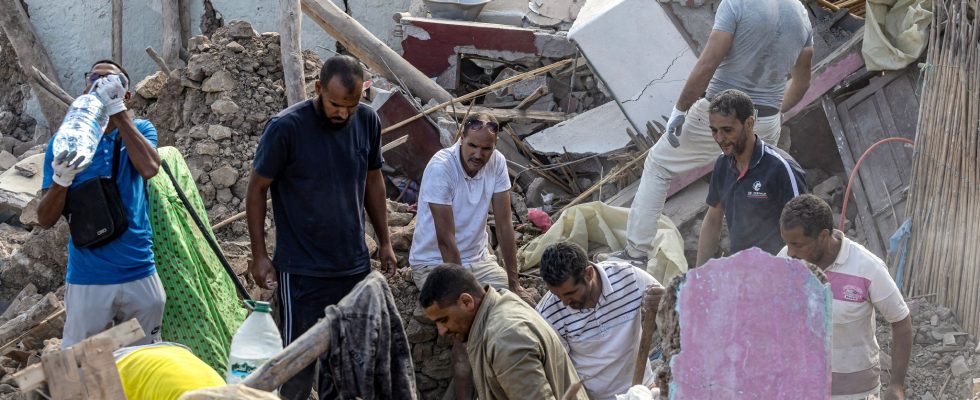The consequences of the earthquake are still being felt in Morocco, while Rabat accepted aid from four friendly countries (Spain, United Kingdom, Qatar and United Arab Emirates) on Sunday evening. This Monday, September 11, Moroccan relief workers continue to look for survivors of the earthquake that struck the southwest of the country three days earlier.
A race against time to slow down the already heavy toll of 2,500 deaths following this earthquake, measured at 6.8 on the Richter scale, according to the Moroccan Center for Scientific and Technical Research. But if the use of this scale is familiar to us, it is not the most relevant to talk about this earthquake.
An old ladder unsuitable for large earthquakes
To understand why the Richter scale is imperfect, we must go back to the history of its creation. In 1935, two professors from Caltech University, Beno Gutenberg and Charles Francis Richter, developed one of the first scales to classify the intensity of the seismic phenomena they studied. It gives a score of 1 to 10 to these earthquakes according to a so-called “logarithmic” scale: the energy of an earthquake measured at 5 is thirty times greater than another measured at 4, and so on.
Problem: The Richter scale was developed for very specific phenomena. “Earthquakes in Southern California […] recorded using the Wood-Anderson seismograph and whose epicenters were less than 600 kilometers from the seismograph location”, recalls the site of the Encyclopedia Britannica.
Gold, as explained by the United States Geological Survey (USGS), “as more and more seismographic stations were installed around the world, it became clear that the method developed by Richter was strictly valid only for certain frequency and distance ranges.” According to Pacific Northwest Seismic Network (PNSN)the Richter method “was never intended to measure large or distant earthquakes”: beyond 5.8, as is the case for Friday’s Moroccan earthquake, it “saturates” and loses precision.
One magnitude to rule them all
Over time, specialists have developed other types of scales to classify earthquakes. More suited to shocks close to the measuring instrument, the Richter scale is thus renamed local magnitude (ML), while two other methods are developed, details the PNSN: the magnitude of volume waves (Mb), used mainly for deep earthquakes or “more than 3,000 kilometers from the recording station”, and the magnitude of surface waves (MS), more suitable for tremors which travel very large distances.
More precise options but which each have their flaws. However, in the 1970s, the advancement of technologies in this science brought a new scale to govern them all: the moment magnitude (Mw). A more universal measurement because it “is linked to the total energy released during the earthquake” and “is valid across the entire range of magnitudes,” explains the United States Geological Survey. It is also the only one applicable to earthquakes of more than 8 magnitude.
“What you need to remember: the Richter magnitude is observational, while the moment magnitude is precisely quantifying the physics of the process,” summarizes Romain Jolivet, university professor in the school’s Geosciences department. higher normal of Paris.
However, the press and the public therefore continue to use the Richter scale out of habit, since it is the one we know best. “I believe that seismologists have never been very clear on this subject, believes Romain Jolivet. So when this percolates into the general public, we can hear things like ‘Richter magnitude of moment’ or I don’t know what. We mix everything.”
Larger differences in the face of the worst earthquakes
Without inventing any fanciful measurement, continuing to talk about the Richter scale instead of the moment magnitude is not so serious, judges the academic: “For us it is very important if we are a little wrong , because the difference in energy released between a magnitude 5 and 6 is thirty times greater. But for the general public, it is not very serious.”
As the Pacific Northwest Seismic Network (PNSN) explains, “all of these approaches were calibrated and defined against each other” using a logarithmic scale of 1 to 10 – a low or medium intensity earthquake will be measured almost the same way on each of these scales. Thus, for the Moroccan earthquake last Friday, the moment magnitude, like that measured by the Richter scale, is estimated at 6.8.
Romain Jolivet thus explains that “with each earthquake, there is a small debate in the community”, since it is first necessary to establish a calculation model based on the particularities of the earthquake before obtaining a magnitude.
The specialist gives the example of the 2011 earthquake in Japan, responsible for the Fukushima disaster, for which the calculation models initially capped at a magnitude of 8, while the tremor was finally measured at 9. For Romain Jolivet, “we must be able to measure this magnitude as quickly as possible in order to be able to trigger alerts as soon as possible”.
